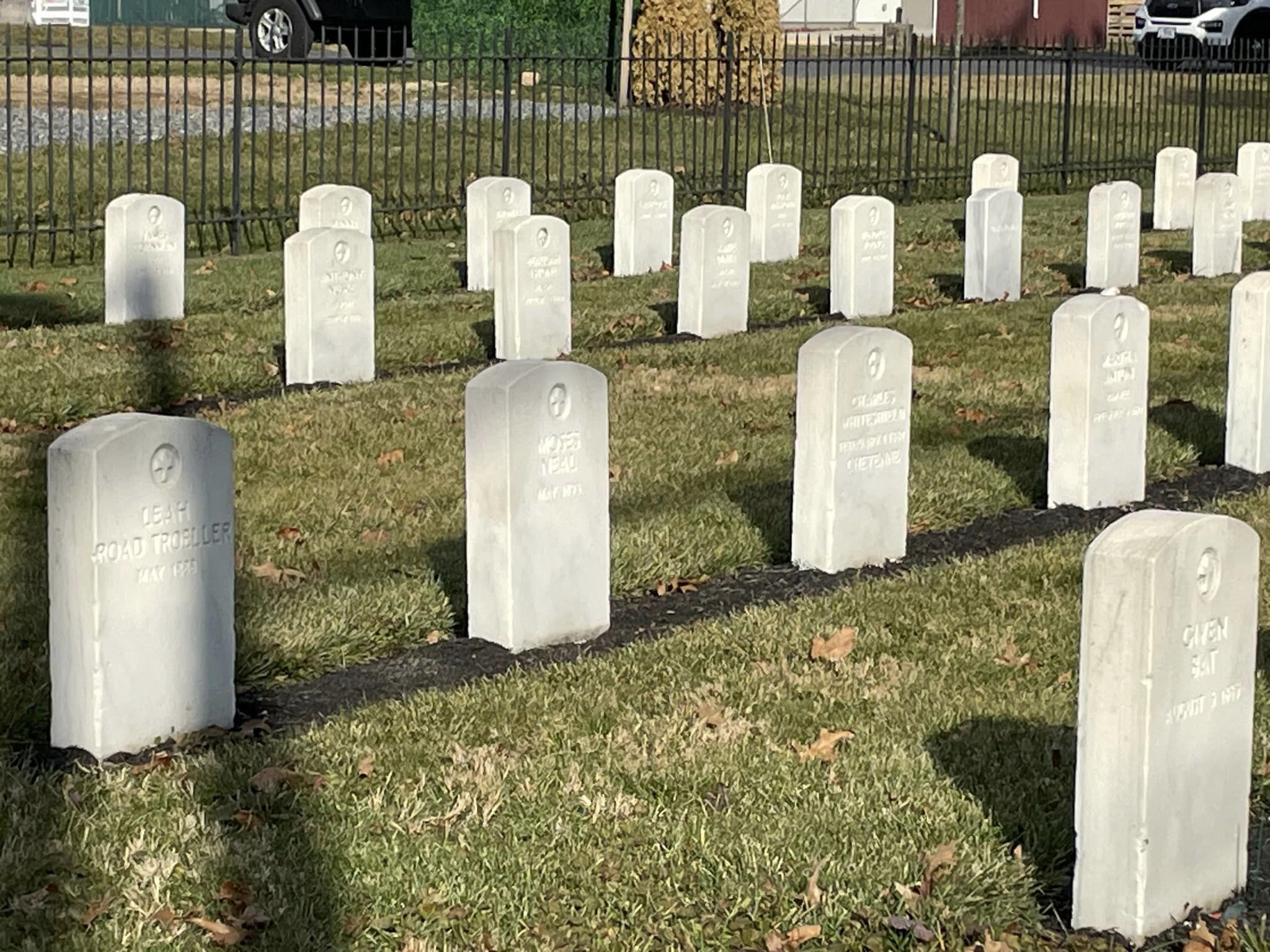
- Details
- By Levi Rickert
Opinion. The sky was blue and temperatures were unseasonably warm as we pulled into the Carlisle Barracks campus at the former Indian boarding school. A couple of small children could be heard talking as they played and ran with a large yellowish-brown dog following closely behind. They were joyful. Then, one of the children, a young girl, ran onto a porch and disappeared into the white apartment building that is part of the large complex that houses officers who attend the U.S. Army War College.
A plaque facing the sidewalk identifies the apartment complex as being the Coren Apartments, which date back to the Revolutionary War. The apartments were burned down during the Civil War, but quickly rebuilt. During the Indian boarding school era, the apartments served as a girl’s dormitory. At one point, the corner apartment the young girl had entered had served as the office of Lt. Col. Richard Henry Pratt, who founded Carlisle Indian Industrial School in 1879 and served as the school’s superintendent until 1904.
In comments made at a social reform conference in 1892, Pratt said in an overview of his Indian boarding-school superintendent role: “Indians had been forced onto remote reservations, far from the ‘civilizing’ influence of English-speaking peoples.”
In the speech, he cited a quote popular during the Indian wars: “The only good Indian is a dead one.”
He expounded on the remark: “In a sense, I agree with the sentiment,” Pratt opined, “but only in this: that all the Indian there is in the race should be dead. Kill the Indian in him, and save the man.”
Pratt’s comments that day became famous, if in a slightly pithier form: “Kill the Indian, save the man.”
The phrase became the mantra for the federal Indian boarding school’s assimilation period.
From 1879 until 1918, during its 39 years of operation, Carlisle Indian Industrial School housed 7,800 Native American children from more than 140 tribal nations from as far away as Alaska. The Native American children were exposed to a mix of Western-style education with a strong militaristic influence and hard labor.
The Native American students were forced to cut their hair, adopt English names, forbidden from speaking their tribal languages, and Christianized. Many endured physical and emotional abuse. Since the school was on the Carlisle Barracks, which dates back to the Revolutionary War, the campus was actually an Army base. It was convenient for Pratt to insist that the Native American students be treated as soldiers rather than school students. With the militaristic treatment of Native Americans came confinement in small prison-like structures that were used frequently to hold students in solitary — much like prisoners, rather than students.
While Carlisle was in operation, close to 200 children from 59 different tribes died there. Many died of diseases made worse by poor living conditions and abuse, and were buried at the school. According to the Federal Indian Boarding School Initiative Investigative Report (Volume I), authored by Interior Assistant Secretary - Indian Affairs Bryan Newland (Bay Mills Indian Community), about one-quarter of those who died at the school were Apache.
Native New Online’s senior reporter Jenna Kunze has covered three disinterments from the Carlisle Cemetery over the course of the past two years. Since I have not been able to attend these, I wanted to visit Carlisle for my own experience. I did that on a recent Friday on my way back to Michigan from the White House Tribal Nations Summit in Washington. This was my first visit there.
The Carlisle Indian Industrial School closed in 1918 because the U.S. Army needed the facility after the United States entered World War I. The Carlisle Barracks returned to serve as a military base. Injured soldiers were nursed back to health at Carlisle.
 Make A Donation Here
Make A Donation Here
I have read many books and stories about Carlisle. I have even written about Carlisle many times over the past dozen years, especially since 2021 when the Indian boarding school story emerged in public awareness. Carlisle is even romanticized because the great Jim Thorpe (Sac & Fox/Potawatomi) was a student there and played football.
The visit provided me with a better perspective of the militaristic side to how the boarding school was operated. Integrated into a small museum are photographs of the Carlisle Indian boarding school. Another section touts the alumni of the U.S. War College, including current Secretary of Defense Llyod Austin.
My tour of Carlisle concluded with a trip to the Carlisle Cemetery, which was relocated in 1931 to make room for new Army buildings. I was surprised to see the location of the cemetery was located inside a fence close to a street that is heavily used by the public. Through the black-iron fence, you can almost touch the rows of white headstones of almost 200 Native students who are buried there.
Walking through the cemetery and seeing the military-like white headstones of innocent, dead Native American children — all far from their tribal homes — was an overwhelming experience. The headstones bore a tribal affiliation, date and in some cases but not all, a name. I wept.
“They were so far from their homes,” I told my friend, Eugene, who I was traveling with. The tears flowed like a river.
My visit to Carlisle was part of the personal journey I have been experiencing over the past three years covering Indian boarding schools and the era of assimilation. In May 2022 I walked the grounds of the Genoa Indian Industrial School in Nebraska where my grandmother Ellen Moore Whitepigeon attended as a child. Beginning in July, I attended 11 of the 12 stops on the Interior Department’s Road to Healing tour that captured stories of the survivors of Indian boarding schools and descendents of those who attended.
Since my visit to Carlisle, I keep thinking about the vast contrast between the two joyful young children I had seen running so close to Pratt’s former office, where he undoubtedly made decisions that caused hardships for Native children who were treated more as prisoners than students. Talk about a tale of two cities.
All children should be able to enjoy their childhoods as the children of Army officers I saw that day. Sadly, Native American children confined to Carlisle Indian Industrial School did not.
Thayék gde nwéndëmen - We are all related.
More Stories Like This
Senator Ben Nighthorse Campbell Proved Representation MattersThe Lie We Keep Telling About Wounded Knee
Another Weapon of Mass Destruction
Colorado cannot heal until it confronts Sand Creek honestly
Native American Mothers Deserve to Live
Help us defend tribal sovereignty.
At Native News Online, our mission is rooted in telling the stories that strengthen sovereignty and uplift Indigenous voices — not just at year’s end, but every single day.
Because of your generosity last year, we were able to keep our reporters on the ground in tribal communities, at national gatherings and in the halls of Congress — covering the issues that matter most to Indian Country: sovereignty, culture, education, health and economic opportunity.
That support sustained us through a tough year in 2025. Now, as we look to the year ahead, we need your help right now to ensure warrior journalism remains strong — reporting that defends tribal sovereignty, amplifies Native truth, and holds power accountable.
 The stakes couldn't be higher. Your support keeps Native voices heard, Native stories told and Native sovereignty defended.
The stakes couldn't be higher. Your support keeps Native voices heard, Native stories told and Native sovereignty defended.
Stand with Warrior Journalism today.
Levi Rickert (Potawatomi), Editor & Publisher

